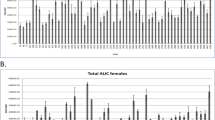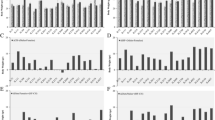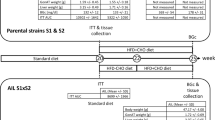Abstract
Type-2 diabetes (T2D) is a complex metabolic disease characterized by impaired glucose tolerance. Despite environmental high risk factors, host genetic background is a strong component of T2D development. Herein, novel highly genetically diverse strains of collaborative cross (CC) lines from mice were assessed to map quantitative trait loci (QTL) associated with variations of glucose-tolerance response. In total, 501 mice of 58 CC lines were maintained on high-fat (42 % fat) diet for 12 weeks. Thereafter, an intraperitoneal glucose tolerance test (IPGTT) was performed for 180 min. Subsequently, the values of Area under curve for the glucose at zero and 180 min (AUC0−180), were measured, and used for QTL mapping. Heritability and coefficient of variations in glucose tolerance (CVg) were calculated. One-way analysis of variation was significant (P < 0.001) for AUC0−180 between the CC lines as well between both sexes. Despite Significant variations for both sexes, QTL analysis was significant, only for females, reporting a significant female-sex-dependent QTL (~2.5 Mbp) associated with IPGTT AUC0−180 trait, located on Chromosome 8 (32–34.5 Mbp, containing 51 genes). Gene browse revealed QTL for body weight/size, genes involved in immune system, and two main protein-coding genes involved in the Glucose homeostasis, Mboat4 and Leprotl1. Heritability and coefficient of genetic variance (CVg) were 0.49 and 0.31 for females, while for males, these values 0.34 and 0.22, respectively. Our findings demonstrate the roles of genetic factors controlling glucose tolerance, which significantly differ between sexes requiring independent studies for females and males toward T2D prevention and therapy.





Similar content being viewed by others
References
Abu Toamih-Atamni HJ, Mott R, Soller M, Iraqi FA (2016a) High-fat induced development of increased fasting glucose levels and impaired response to intraperitoneal glucose challenge in collaborative cross mouse reference population. BMC Genet 17:10
Abu Toamih-Atamni H, Botzman M, Mott R, Gat-Vicks I, Iraqi FA (2016b) Mapping quantitative trait loci associated with host susceptibility to non-alcoholic fat liver accumulations using collaborative cross mouse genetic reference population. Mamm Genome J. July 15, [Epub ahead of print], doi: 10.1007/s00335-016-9658-3
Ahmed AM (2002) History of diabetes mellitus. Saudi Med J 23:373–378
Aylor DL, Valdar W, Foulds-Mathes W, Buus RJ, Verdugo RA et al (2011) Genetic analysis of complex traits in the emerging collaborative cross. Genome Res 21:1213–1222
Bao W, Hu FB, Rong S, Rong Y, Bowers K et al (2013) Predicting risk of type-2 diabetes mellitus with genetic risk models on the basis of established genome-wide association markers: a systematic review. Am J Epidemiol 178:1197–1207
Behnke JM, Menge DM, Nagda S, Noyes H, Iraqi FA et al (2010) Quantitative trait loci for resistance to Heligmosomoidesbakeri and associated immunological and pathological traits in mice: comparison of loci on chromosomes 5, 8 and 11 in F2 and F6/7 inter-cross lines of mice. Parasitology 137:311–320
Blackshaw S, Harpavat S, Trimarchi J, Cai L, Huang H et al (2004) Genomic analysis of mouse retinal development. PLoS Biol 2:E247
Brennan TA, Egan Kevin P, Carter M et al (2014) Mouse models of telomere dysfunction phenocopy skeletal changes found in human age-related osteoporosis. Dis Models Mech 7:583–592
Caglayan EK, Engin-Ustun Y, Sari N, Karacavus S, Seckin L et al (2015) Evaluation of bone density measurement in type-2 diabetic postmenopausal women with hypertension and hyperlipidemia. J Menopausal Med 21:36–40
Carnevale V, Romagnoli E, D’Erasmo L, D’Erasmo E (2014) Bone damage in type 2 diabetes mellitus. Nutr Metab Cardiovasc Dis 24:1151–1157
Churchill G, Airey D, Allayee H, Angel J, Attie A et al (2004) Complex trait consortium. The collaborative cross, a community resource for the genetic analysis of complex traits. Nat Genet 36:1133–1137
Cox RD, Church CD (2011) Mouse models and the interpretation of human GWAS in type 2 diabetes and obesity. Dis Model Mech 4:155–164
Dorman A, Baer Daria, Tomlinson I, Mott R, Iraqi FA (2016) Genetic analysis of intestinal polyp development in collaborative cross mice carrying the ApcMin/+ mutation. BMC Genet 17:46
Durrant C, Tayem H, Yalcin B, Cleak J, Goodstadt L et al (2011) Collaborative cross mice and their power to map host susceptibility to Aspergillus fumigatus infection. Genome Res 21:1239–1248
Gittelsohn J, Wolever TM, Harris SB, Harris-Giraldo R, Hanley AJ, Zinman B (1998) Specific patterns of food consumption and preparation are associated with diabetes and obesity in a Native Canadian community. J Nutr 128:541–547
Global Health Estimates: deaths by cause, age, sex and country, 2000–2012 (2014a) World Health Organization (WHO), Geneva. http://www.who.int/healthinfo/global_burden_disease/estimates/en/index1.html. Accessed 13 June 2016
Global status report on noncommunicable diseases (2014b) World Health Organization (WHO). http://www.who.int/nmh/publications/ncd-status-report-2014/en/. Accessed 25 Nov 2015
Guraya SY (2015) Association of type 2 diabetes mellitus and the risk of colorectal cancer: a meta-analysis and systematic review. World J Gastroenterol 21:6026–6031
Harris MI, Eastman RC, Cowie CC, Flegal KM, Eberhardt MS (1999) Racial and ethnic differences in glycemic control of adults with type 2 diabetes. Diabetes Care 22:403–408
Hoffman BG, Zavaglia B, Witzsche J, Ruiz de Algara T, Beach M et al (2008) Identification of transcripts with enriched expression in the developing and adult pancreas. Genome Biol 9:R99
Hofmann K (2000) A superfamily of membrane-bound O-acyltransferases with implications for wnt signaling. Trends Biochem Sci 25:111–112
Iraqi F, Churchill G, Mott R (2008) The Collaborative Cross, developing a resource for mammalian systems genetics: a status report of the welcome trust COHORT. Mamm Genome 19:379–381
Iraqi FA, Mahajne M, Salaymah A, Sandovsky H, Tayem H et al (2012) The genome architecture of the collaborative cross mouse genetic reference population collaborative cross consortium. Genetics 190:389–402
Iraqi AF, Athamni H, Dorman A, Salymah Y, Tomlinson I, Nashif A, Shusterman A, Weiss E, Houri-Haddad Y, Mott R, Soller M (2014) Heritability and coefficient of genetic variation analyses of phenotypic traits provided strong basis for high-resolution QTL mapping in the collaborative cross mouse reference population. Mamm Genome 25(3):109–119
Kirchner H, Heppner KM, Holland J, Kabra D, Tschöp MH et al (2013) Ablation of ghrelin O-acyltransferase does not improve glucose intolerance or body adiposity in mice on a leptin-deficient ob/ob background. PLoS ONE 8:e61822
Leiter EH (2009) Selecting the “Right” mouse model for metabolic syndrome and type 2 diabetes. T2 diabetes. Methods Mol Biol 560:1–17
Levy R, Mott R, Iraqi FA, Gabetp Y (2015) Collaborative cross mice in a genetic association study reveal new candidate genes for bone microarchitecture. BMC Genom 16(1013):1–14
Lore’ NI, Iraqi FA, Bragonzi A (2015) Host genotype an important determinant factor of Pseudomonas aeruginosa susceptibility in the collaborative cross mice. BMC Genet 16:1
Mathen PG, Thabah MM, Zachariah B, Das AK (2015) Decreased bone mineral density at the femoral neck and lumbar spine in south indian patients with Type 2 diabetes. J Clin Diagn Res 9:OC08
Mathers CD, Loncar D (2006) Projections of global mortality and burden of disease from 2002 to 2030. PLoS Med 3:e442
MazónPeláez I, Vogler S, Strauss U, Wernhoff P, Pahnke J et al (2005) Identification of quantitative trait loci controlling cortical motor evoked potentials in experimental autoimmune encephalomyelitis: correlation with incidence, onset and severity of disease. Hum Mol Genet 14:1977–1989
Mohlke KL, Boehnke M (2015) Recent advances in understanding the genetic architecture of type 2 diabetes. Hum Mol Genet 24:R85
Montgomery MK, Hallahan NL, Brown SH et al (2013) Mouse strain-dependent variation in obesity and glucose homeostasis in response to high-fat-feeding. Diabetologia 56:1129–1139
Otto JM, Cs-Szabó G, Gallagher J, Velins S, Mikecz K et al (1999) Identification of multiple loci linked to inflammation and autoantibody production by a genome scan of a murine model of rheumatoid arthritis. Arthritis Rheum 42:2524–2531
Paterson AH (1995) Molecular dissection of quantitative traits: progress and prospects. Genom Res 5:321–333
Philip VM, Sokoloff G, Ackert-Bicknell CL, Striz M, Branstetter L et al (2011) Genetic analysis in the collaborative cross breeding population. Genom Res 21:1223–1238
Qi L, Liang J (2010) Interactions between genetic factors that predict diabetes and dietary factors that ultimately impact on risk of diabetes. Curr Opin Lipidol 21:31–37
Qi L, Hu FB, Hu G (2008) Genes, environment, and interactions in prevention of type2 diabetes: a focus on physical activity and lifestyle changes. Curr Mol Med 8:519–532
Robling AG, Warden SJ, Shultz KL, Beamer WG, Turner CH (2007) Genetic effects on bone mechanotransduction in congenic mice harboring bone size and strength quantitative trait loci. J Bone Miner Res 22:984–991
Rocha JL, Eisen EJ, Van Vleck LD, Pomp D (2004) A large-sample QTL study in mice: I. Growth Mamm Genom 15:83–99
Rogers LK, Bates CM, Welty SE, Smith CV (2006) Diquat induces renal proximal tubule injury in glutathione reductase-deficient mice. Toxicol Appl Pharmacol 217:289–298
Saydah S, Cowie C, Eberhardt MS, De Rekeneire N, Narayan KM (2007) Race and ethnic differences in glycemic control among adults with diagnosed diabetes in the United States. Ethn Dis 17:529–535
Shusterman A, Salymah Y, Nashef A, Soller M, Wilensky A, Mott R, Weiss EI, Houri-Haddad Y, Iraqi FA (2013) Genotype is an important determinant factor of host susceptibility to periodontitis in the collaborative cross and inbred mouse populations. BMC Genet 14:68–79
Soller M, Fuad Iraqi FA (2014) The collaborative cross—A next generation mouse genetic resource population for high resolution genomic analysis of complex traits. Livest Sci J 166:19–25
Stevens JW, Khunti K, Harvey R, Johnson M, Preston L et al (2015) Preventing the progression to type 2 diabetes mellitus in adults at high risk: a systematic review and network meta-analysis of lifestyle, pharmacological and surgical interventions. Diabetes Res Clin Pract 107:320–331
Threadgill DW, Churchill GA (2012) Ten years of the collaborative cross. Genetics 190:291–294
Touvier T, Conte-Auriol F, Briand O, Cudejko C, Paumelle R et al (2009) LEPROT and LEPROTL1 cooperatively decrease hepatic growth hormone action in mice. J Clin Invest 119:3830–3838
van Dam RM, Rimm EB, Willett WC, Stampfer MJ, Hu FB (2002) Dietary patterns and risk for type 2 diabetes mellitus in U.S. men. Ann Intern Med 136:201–209
vanWezel T, Ruivenkamp CA, Stassen AP, Moen CJ, Demant P (1999) Four new colon cancer susceptibility loci, Scc6 to Scc9 in the mouse. Cancer Res 59:4216–4218
Vered K, Durrant C, Mott R, Iraqi FA (2014) Susceptibility to Klebsiella pneumonaie infection in collaborative cross mice is a complex trait controlled by at least three loci acting at different time points. BMC Genom 15:865
Welsh CE, Miller RD, Manly KF, Wang J, McMillan L et al (2012) Status and access to the collaborative cross population. Mamm Genome 23:706–712
Yalcin B, Flint J, Mott R (2005) Using progenitor strain information to identify quantitative trait nucleotides in outbred mice. Genetics 171:673–681
Yan J, Meng X, Wancket LM, Lintner K, Nelin LD et al (2012) Glutathione reductase facilitates host defense by sustaining phagocytic oxidative burst and promoting the development of neutrophil extracellular traps. J Immunol 188:2316–2327
Yang J, Brown MS, Liang G, Grishin NV, Goldstein JL (2008) Identification of the acyltransferase that octanoylates ghrelin, an appetite-stimulating peptide hormone. Cell 132:387–396
Yang H, Ding Y, Hutchins LN, Szatkiewicz J, Bell TA et al (2009) A customized and versatile high-density genotyping array for the mouse. Nat Methods 6:663–666
Acknowledgments
The present work is part of a Ph.D. thesis by Hanifa J. Abu-Toamih Atamni. This work was supported by the Hendrech and Eiran Gotwert Fund for studying diabetes; Wellcome Trust Grants 085906/Z/08/Z, 075491/Z/04; Wellcome Trust Core Funding Grant 090532/Z/09/Z; and Core Funding by Tel-Aviv University.
Author information
Authors and Affiliations
Corresponding author
Ethics declarations
Conflict of Interest
The authors declare no competing financial interests or other associations that might pose a conflict of interest (e.g., pharmaceutical stock ownership, consultancy).
Rights and permissions
About this article
Cite this article
Abu-Toamih Atamni, H.J., Ziner, Y., Mott, R. et al. Glucose tolerance female-specific QTL mapped in collaborative cross mice. Mamm Genome 28, 20–30 (2017). https://doi.org/10.1007/s00335-016-9667-2
Received:
Accepted:
Published:
Issue Date:
DOI: https://doi.org/10.1007/s00335-016-9667-2




